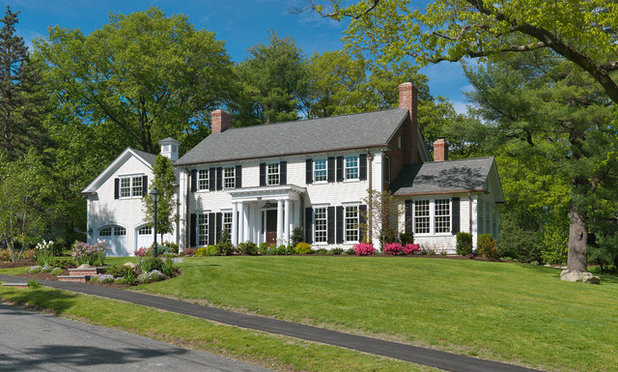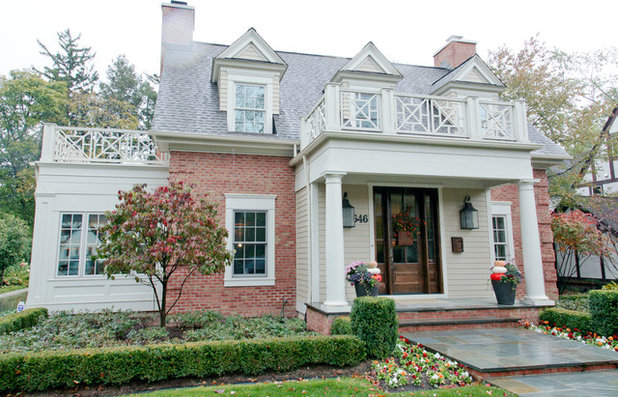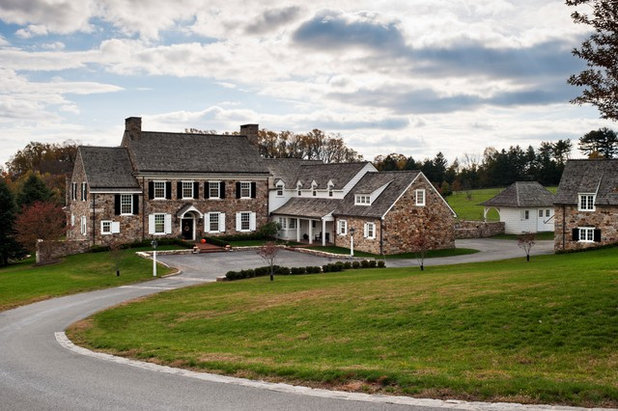Because this is an eclectic style, you’ll find a wide variety of forms and details. The Dutch colonial, with its gambrel roof, is a popular subtype. Most colonial revivals are symmetrical two-story homes, but you’ll also find asymmetrical and one-story colonials, as well as some with postmedieval influences.
Hansen Architects, P.C.
Another subtype of the style has a hipped roof and full-width porch on the main level, like this house. Compare it to the similar composition of neoclassical designs, in which the porch rises two floors. In addition, the hipped and centered dormer, along with the centered triple upper-floor window, helps to define this home as an eclectic colonial revival.
RWA Architects
At first glance you might consider this house Georgian, but take a closer look at the fenestration. Commonly on colonial revivals, the lower-level windows are grouped rather than spaced apart like the upper-floor windows. The double-hung windows have divided panes, or lights, on the upper sash, but have a single pane of glass on the lower sash, a trait common to the revival but not used on authentic colonial houses.
Keeping in mind the eclectic nature of the revival, unusual here are the eave brackets, which are reminiscent of the Italianate style. Also note the brick. Many early examples of the style had wood siding, but grand examples were full masonry construction. It was not until the early 1920s that the technique of brick veneering developed, and it became the fashionable choice for many colonial revivals built after then, as exemplified here.
The architects have labeled this house as a foursquare, which describes its building type, rather than its style. Colonial revival foursquares are common, as are Prairie-inspired foursquares. A foursquare is simply a plan with two levels, each two rooms wide and two rooms deep. The style is established in the details of windows, cornices, porches and entrances.
Keeping in mind the eclectic nature of the revival, unusual here are the eave brackets, which are reminiscent of the Italianate style. Also note the brick. Many early examples of the style had wood siding, but grand examples were full masonry construction. It was not until the early 1920s that the technique of brick veneering developed, and it became the fashionable choice for many colonial revivals built after then, as exemplified here.
The architects have labeled this house as a foursquare, which describes its building type, rather than its style. Colonial revival foursquares are common, as are Prairie-inspired foursquares. A foursquare is simply a plan with two levels, each two rooms wide and two rooms deep. The style is established in the details of windows, cornices, porches and entrances.
Jan Gleysteen Architects, Inc
This 1938 New England colonial revival confirms its classification by its date of construction. As the popularity of this fashion persisted through the decades, tastes for more architecturally correct designs resulted in many examples being nearly identical to the Georgian and Adam houses that provided their inspiration. Place yourself back 80 years and imagine comparing this house to one that was 100 years old at that time. The differences would be easy to see, because the more precise execution of machine-finished details on the newer house would be obvious.
Notice the replicated Georgian entrance surround and its classically detailed entrance porch. Many variations and combinations of these two elements alone help to define the colonial revival style.
Notice the replicated Georgian entrance surround and its classically detailed entrance porch. Many variations and combinations of these two elements alone help to define the colonial revival style.
Morgante Wilson Architects
Notice the variety of window shapes and configurations in this side-gabled Chicago colonial revival. Dormers atop have an arch; there are two sizes on the second level; and tall, narrow French casements complete the theme on the main level. A small rounded and classically detailed entrance porch shelters a modestly styled Georgian entrance surround.
The winged extension to the left is another indicator of colonial revival. Flat-roofed portions like this one could be enclosed or used as a porch, and were often added to original Georgian and Adam houses over the years.
The winged extension to the left is another indicator of colonial revival. Flat-roofed portions like this one could be enclosed or used as a porch, and were often added to original Georgian and Adam houses over the years.
Rock Spring Design Group LLC (David Verespy, ASLA)
A mixture of materials, details and windows makes for a unique composition here. Double-hung windows are characteristically grouped on the first level but are capped with a wood lintel supporting the stone veneer. The balanced placement of oval windows and the classically detailed porch and entrance surround confirm its relation to Renaissance architecture, which supported the Georgian era. The combination of colonial details and otherwise rustic appearance continue to be favored in neoeclectic versions of colonial revivals.
Dwellings
One-story versions are often called Cape Cods; they have roots in the earliest coastal New England settlements. Other versions of this form were reinterpreted in the Southeastern U.S., but were built mostly after colonial times. The configuration, as in this example, is still very popular and appears in regional varieties throughout the country. This modern house can be considered neoeclectic. Notice the wing to the left and the brick veneer quoins.
Steven Corley Randel, Architect
Though this 1941 California house is in need of some TLC, it marvelously demonstrates another subtype of the revival, known as the Garrison colonial. The inspiration goes all the way back to postmedieval New England houses. Several traits seen here are common to this type.
Postmedieval English houses often had a slight overhang of the second level, as does this house. Look closely at the underside of the overhang and note the dangling pendants, another medieval trait and sometimes found in Garrisons. The overhang also provides a roof for the large bay windows, which became very popular in several styles through the 1950s.
As in this elevation, Garrisons often had brick-veneer first levels and wood-clad second floors. This example goes a little further with second-floor windows set into wall dormers with segmental arched shapes and arched divided-light details.
Postmedieval English houses often had a slight overhang of the second level, as does this house. Look closely at the underside of the overhang and note the dangling pendants, another medieval trait and sometimes found in Garrisons. The overhang also provides a roof for the large bay windows, which became very popular in several styles through the 1950s.
As in this elevation, Garrisons often had brick-veneer first levels and wood-clad second floors. This example goes a little further with second-floor windows set into wall dormers with segmental arched shapes and arched divided-light details.
Dennis Mayer - Photographer
Compare the previous house to this San Francisco–area Garrison interpretation. At right the second level characteristically overhangs the first. A similar prominent bay window comes forward under its own gable. It is likely that the wing to the left is an addition to the original house.
Dennison and Dampier Interior Design
A subtype with a projecting center gable is less common. Notice the single-level porch here. Had the columns risen to the second level, this would more closely follow Greek revival design. Pilasters at the corners and a Palladian window in the pediment provide more colonial revival identity. This house also has a flat-roof wing at left and 16- over 16-pane double-hung windows.
Wright Building Company
The colonial revival houses still being built are probably best defined as neoeclectic. The mixture of rustic stone and classical details has become very popular, as can be seen in the next three examples.
While the center body of this house follows the traditional configuration, a wing at left and the protruding garage wing at right bring this example firmly into the 21st century. Classical proportions and details mix with a compound plan, establishing a handsome and proud appearance.
While the center body of this house follows the traditional configuration, a wing at left and the protruding garage wing at right bring this example firmly into the 21st century. Classical proportions and details mix with a compound plan, establishing a handsome and proud appearance.
Peter Zimmerman Architects
Even more asymmetrical than the previous example, this house is extended in a similar compound formation. Several different secondary elements, such as the dormers and chimneys, dance from one end to the other. Stone covers the two center forms, helping to anchor its position and providing contrast to the clapboard wings.
E. B. Mahoney Builders, Inc.
Note the subtle asymmetry on this house. As far back as the Queen Anne style, the classical detailing of the colonial revival would be applied to less-formal front views.
The colonial revival has its deepest roots in Renaissance classical architecture. However, true to the eclectic designation, it borrows from and bridges other popular styles.
The colonial revival became overshadowed in the first two decades of the 20th century by Craftsman and Prairie styles, early forms of modern architecture. Yet it trumped those two styles in the decades after World War I, as did American Tudor, Spanish and French eclectic, chateauesque and several other fashions.
By the 1960s another wave of modern architecture, this time midcentury, suppressed the colonial revival as an influential and dominating preference across the United States. But the traditional style of the colonial revival is likely to persist indefinitely, partly because it has so much historical importance and is such a timeless and popular look.
The colonial revival has its deepest roots in Renaissance classical architecture. However, true to the eclectic designation, it borrows from and bridges other popular styles.
The colonial revival became overshadowed in the first two decades of the 20th century by Craftsman and Prairie styles, early forms of modern architecture. Yet it trumped those two styles in the decades after World War I, as did American Tudor, Spanish and French eclectic, chateauesque and several other fashions.
By the 1960s another wave of modern architecture, this time midcentury, suppressed the colonial revival as an influential and dominating preference across the United States. But the traditional style of the colonial revival is likely to persist indefinitely, partly because it has so much historical importance and is such a timeless and popular look.












0 comments:
Post a Comment